Baseball Softball Toe Tap Vs No Stride Length? How To Hit Better, Farther, & With Power | Lower Half Swing Experiment & Best Load Mechanics Of MLB Hitters
Discover how much the baseball and softball toe tap, long stride length, or no stride contributes to bat speed. Does stride help to hit the ball better, farther, and with power? Learn lower half swing experiment and best load mechanics of MLB hitters…
Troy Tulowitzki Swing Breakdown: Stride Killing Bat Speed?
Question: Does Stride Length Kill Bat Speed?
Using the Zepp (Labs) Baseball app, I wanted to use the Scientific Method to analyze whether Troy Tulowitzki’s longer stride increases or decreases bat speed. Not just a longer stride, but I want to see the torso moving forward as well.
Background Research
Troy Tulowitzki had a wider stance in 2013. In 2014, he’s adopted more of a narrow stance and a longer stride length.
Forward Momentum may be a new concept to hitting, but not to other explosive rotational athletes. It’s also known as the Conservation of Linear Momentum and the Un-Weighting Principal. The idea is that the hitter is getting a “head start”. Other high level athletes using Forward Momentum:
- Olympic Throwers (Discus, Javelin, and Hammer)
- Olympic Shot Put
- 4 X 100 meter relay sprinters
- Circus Trapeze Artists
- Lacrosse Players
- Hockey Players
SCIENCE-BASED TRAINING:
Improve your hitting strategy dramatically by applying human movement principles.
Learn not only how and what to train but also the science behind the methods.
Hypothesis
I think the addition of forward momentum, or a longer stride length, will contribute to more bat speed because this gives the hitter a “head start”, making the body feel lighter while moving. This allows the body to turn harder, and ultimately increase bat speed.
Troy Tulowitzki Experiment
Equipment:
- Zepp Baseball app
,
- ATEC Tuffy Batting Tee,
- Rawlings Official NCAA Baseballs,
- Two yellow dimple baseballs,
- Galaxy S3 phone camera, and
- 33 inch, 30 ounce Pinnacle Bamboo bat.
Setup:
- Feedback markers = my bat length, plus two baseballs
- Distance from plate = end of the bat touching inside corner of plate, and knob of bat touching my mid-thigh
- NO-stride stance was width of feedback markers
- Forward movement stance was open, and feet set a little wider than shoulder width
- Tee was set a baseball or two behind the front feedback marker, and tee height was about mid-thigh
- 101 baseballs were hit using both the NO-stride and longer stride sessions
Data Collected:
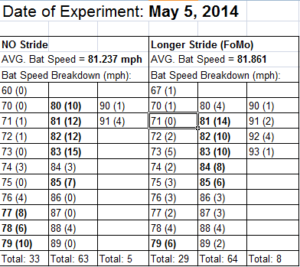
Pay particular attention to the bold typeface…
Data Analysis & Conclusion
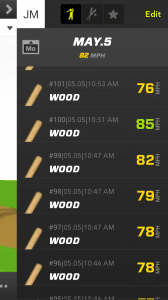
NO-stride: last 6 batted balls (Zepp Baseball app)
- 0.624 mph average bat speed increase with a longer stride.
- Apex of bell curve for NO-stride swings ranged from 77 mph to 83 mph*.
- With a longer stride, you’ll see the bell curve shifted, 81 mph to 85 mph*.
- Three more 90 mph+ swings using a longer stride, in addition to increasing my Personal Record 2 mph.
*Based on six or more batted balls repeated in specific mph (bold typeface in the chart above)
Notes

Longer Stride: last 6 batted balls (Zepp Baseball app)
- Before the experiment I did a 7 minute Dynamic Warm-up.
- I didn’t just increase my stride length, I moved my whole torso forward.
- I began the experiment with the NO-stride swings.
- I took a 20-30 minute break between the two sessions.
- During the last twenty swings of the longer stride session, I hit five-of-eight 90 mph+ balls.
From the Zepp Baseball screenshots to the right, it’s interesting to note, my bat speed kept up, even increased with forward momentum and a longer stride. In other words, I wasn’t as tired at the end of hitting over 200 baseballs.
Now that Troy Tulowitzki is using a more narrow stance and generating forward momentum with a longer stride, he’s able to increase his bat speed. This may explain the surge in opposite field home-runs in 2014.
- Fix Late Swings Fast: 2025 Pitch Recognition & See-Decide-Swing Training for Youth Baseball Power Hitters - October 6, 2025
- Safe Youth Weighted Bat Training: Proven Overload/Underload Drills to Increase Exit Velocity in Games Starting Tonight - September 29, 2025
- AI Coaching Course 2025: Youth Baseball & Softball Practice Plan + Off-Season & In-Season Workout Builder Fast - September 23, 2025


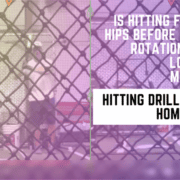


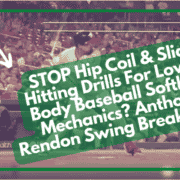
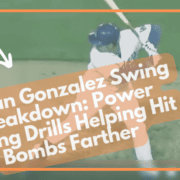






Joey … this goes to show you that the principles of motion will effect everything equally. The unweighting principle applies to our bodies in the same way it applies to a car. Note that there are always city and highway gas MPH given – because once you get the car moving on the highway it takes less energy to keep it going, or to go faster, than it does stopping and starting in the city. Once again you’ve made your point in expert fashion. Great presentation.
Thanks Bob. Next week I’m going to experiment with the Final Turn using a straight front arm versus a bent front arm…
In your forward momentum swing, you’re making contact with your back foot way off the ground and coming forward, whereas the no stride swing the back foot stays on the ground for the most part. if you look at tulo’s swing and pedroia’s swing, they have a big stride forward, but on their load, their feet are almost together, so when they stride they don’t end up so far out that their back-foot has to catch up. the only hitter that i’ve really come across that swings you’re way is trout.
what impact do you think this makes on the swing and the results of your experiment?
Hey Jake. Good observation. I may have to revisit the forward momentum (or un-weighting) part of the experiment. Dedicate one day to just that to really get an idea of increased bat speed. There are other small-bopper hitters who’s back foot comes off the ground and trails the front one: Jose Bautista, Robinson Cano, and Babe Ruth to name a few. Ted Williams back foot actually skipped towards the plate. The important thing is that backside carries zero weight during the swing. The back foot trailing the front helps the hitter gain more stability in the follow through. The farther apart the feet are, the more muscle needed to stabilize in the upper legs (mainly the quads). The more muscle that turns on, the slower the swing.
Do you find your Zepp useful for anything other than bat speed? If so, what? What other ways do you use it?
Ed,
Yes, I’ve used it sparingly so far because I’ve been so busy. The new update allows you to measure ball exit speed and distance the ball traveled now. I don’t think my android app updated yet, but the Apple one has. I still haven’t figured it out yet, but you can track and manage different hitters in the app. This is huge for “what’s measurable, is manageable” when it comes to training hitters. Also, in future articles, I’m going to be running movement experiments with it like I did in the Troy Tulowitzki blog article. Just the fact you can tinker with certain movements, and test to see what the change brings is a big deal. I know $150 is a lot to spend on it, but if you’re interested in the feedback it provides, then it’s well worth it.
I bought it when it came out and used it with my son’s training sessions. It certainly collects a lot of data. But without anything to relate that data to, I don’t know if it was a good swing or not or what to look for and improve. I’m also not sure I trust the accuracy. I often readings that don’t match up with the eye test. For instance, I’ll swing path animations that are completely wacky (they look like someone was chopping wood when I saw them take a normal swing). Essentially, all I really use it for is swing and hand speed. I was hoping to get more out of it.
I know they are constantly working on it so I’ll be patient. I just wanted to hear more about others experiences and learn from them.
Keep up the good work here. I just discovered your site and love what I’m reading/watching.
Thanks!
Ed, I hear you loud and clear. The problem with a lot of these hitting (or human movement) apps, is they don’t tell you how to fix the problem. They just give you data. However, $150 is cheaper to spend than on a Stalker radar gun which is $600! I only use the data after I’ve collected a lot of it. I average all my numbers to correct for outliers. Yes, I’ve experienced the same weird high readings on balls I’ve mishit. It’s not perfect, but if you collect a lot of data points, and average them, then I think it’s worth the feedback. Great concern though 🙂 Don’t worry about grammer. Nobody’s prfect 😉
Wow… Just read my last post… sorry for the grammar issues.
Dear Mr. Myers,
Please comment on Albert Pujols “no-stride” swing technique and bat speed and his effectiveness as a hitter in light of what you have concluded after analyzing Tulo’s forward momentum/long stride swing for increased bat speed.
I teach no-stride to young kids 7-12 due to the complexities that the stride creates for them namely, premature weight shift to front side and head movement with the resulting “eye drop”. In my opinion, from a teaching stand point at an early age, No-stride allows them to keep the weight back and head (eyes) still. These are the two primary deficiencies that should be eliminated or prevented before they are older and/or reach a phase of physical maturity (body control) and an understanding that forward momentum with a longer stride increases bat speed.
I would greatly appreciate your comments on Pujols no-stride. Thank you and keep up the good work!!
Otto, I applaud your effort in thinking of the kids first. I think the problem us coaches have at an early competitive level, is to be too focused on outcomes versus the process. I know how competitive it is at the younger levels, my parents and coaches tell me all about it. And I go to a few tournaments of my hitters, and can feel the pressure around the complex. I don’t like the wide no-stride and sitting back approaches. Forward momentum is one of the first things I teach my 7-9 year olds. It does require some timing calibration, but if you read the “Coaching Baseball” post I did on the Art of Variance, timing is fairly simple for a coach to teach.
Proprioception says that head movement in a swing is inevitable. You’re going to have head movement, it will be before the turn or during the turn. Which would you choose? Hopefully before the turn because we’re not swinging the bat yet. Sitting back causes hitters to have head movement during the turn. I know because I was one of them. I hope this answers your questions. Keep up the good work Coach 🙂
Just curious but with the change in swings forward momentum vs staying back. It seems like power numbers might be up a little now that the rotational swing has become more prevalent over linear swing and forward movement vs. staying back but it seems gone are the days of the .300 hitters especially those that hit for a high avg. .350 plus with doubles power and let’s say the 15 -20 home runs. Also strikeouts tend to be much higher even among good hitters. Could this be a result of the change in philosophies. Ex. You don’t really see the Don mattingly, Kirby Puckett numbers any more with high avg., moderate power but 50 k hitters anymore and looking back at the stats excluding the steroid era the stats seem relatively equal maybe even less 30 homer .300 guys now than pre 1990. Are we sacrificing square the ball up more often than for more power when we do square it up. Strikeouts are outrageous now days. Just asking for your opinion
Al, I think this is a complex issue, going far beyond a purely rotational/linear v. a combination of the two. I think we’re dealing with mechanical challenges…I think vision and tracking plays a role…increased pitching velocity…increase in higher level athletes not focusing on range of motion…mental strategy…I could go on and on. The best thing to do is study the high average, high power swings and see what they all have in common.
Muchas gracias braianz4